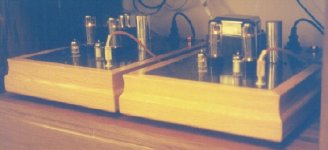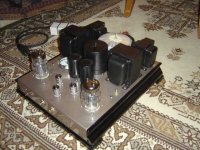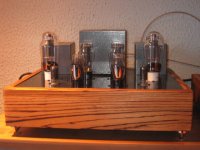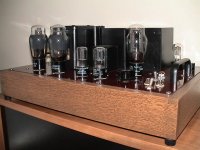Mono Hafler-Keroes original Ultra-Linear circuit, ca. 1951. 6SL7, 6SN7, 6L6G, 274B rectifier, all WWII era military surplus. Everything on this amp is military surplus except the Cardas input jacks - even the Parmeko Atlantic Series OPT which was an unused spare from a British-made flight simulator.
Attachments
My Decware SE84-CS Amp
Attached is a couple images of my Decware SE84-CS with custom wooden case, and matching isolation platform. My current tube configuration consists of a Sophia Electric 274B Mesh, 2 Svetlana SV83 and an Amperex 6DJ8 (Orange Label made in Holland).
I've stabalized a bit on tube rolling and back to just enjoying the music.
I'm very happy with how this both sounds and looks... that was until I saw some of this groups other posts. Very impressive stuff!
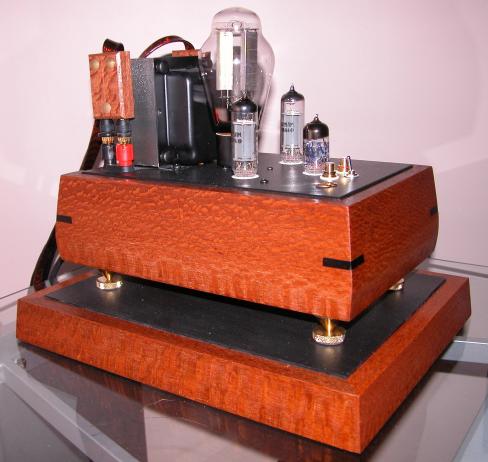
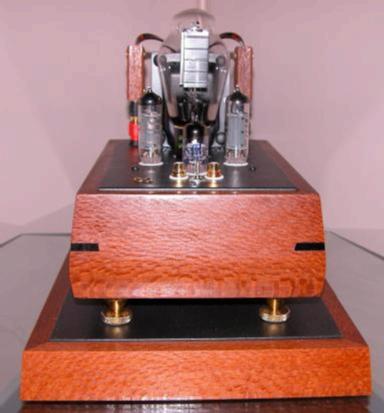
--eric
Attached is a couple images of my Decware SE84-CS with custom wooden case, and matching isolation platform. My current tube configuration consists of a Sophia Electric 274B Mesh, 2 Svetlana SV83 and an Amperex 6DJ8 (Orange Label made in Holland).
I've stabalized a bit on tube rolling and back to just enjoying the music.
I'm very happy with how this both sounds and looks... that was until I saw some of this groups other posts. Very impressive stuff!
--eric
Are those Custom Balanced line inputs with banana's? 
How do they Sound in comparison!?
Do they?
How do they Sound in comparison!?
Do they?
- Prevent great amounts of interference and prevent ground loops?
- Allow a much greater interference to hinder the weak Line signal?
- Provide a better connection for prevention of interference however cannot provide an examination to determine wether ither is true because there is no discernable audible difference?
[/list=a]
*This is not a silver-wire troll. Just curious.
Layberinthius said:Are those Custom Balanced line inputs with banana's?
I'm afriad it's nothing this fancy
I'd been looking for some long (15'+) speaker cables and stumbled on a long run of interesting (unterminated) flat-braided silver litz wire. What you're seeing is an attempt at custom retermination.
While I'm very pleased with the results, the lessons learned here was termination of litz wire is about as enjoyable as an unexpected root canal.
A rather poor pictorial journey of this process is availiable for those interested.
--eric
fdegrove said:Hi,
That cable looks exactly the same as Monitor Audio speaker cable from the late Seventies.
I used it to hook up my homemade Klipschhorns.
What you need is a chemical to bite away the enamel coating at the ends.
Cheers,
Feedback on these cables are very much appreciated! Please tell me more!
The person I bought these from mentioned that they were approximately 25 years old, "Nogami" cables - at the time a top end state of the art Japanese speaker cable. I have not heard of "Nogami" cables (but vaguely familiar with Mogami). Searching the Mogami site however has turned up nothing.
Some addition pictures of these cables are availiable if this might help in identification.
Monitor Audio speaker cables? Any additional information / pointers would be appreciated.
btw - I could find no chemical that would bite away the enamel coating at the ends. In the end a home-made solder pot did the trick.
thanks in advance,
--eric
EC8010 said:Wouldn't paint stripper work? Years ago, I used Polystrippa on Monitor Audio cables. It still needed a spark plug brush to shift the weakened enamel from the (copper) wire, so it was tedious - just as you found.
I would have thought it might (and perhaps in general it would) but it didn't in my case. I even tried several different marine-based stripping solutions (the nastiest) without any success.
The speaker cable seemed to have a much thicker enamel coating than other litz / magnet wire I have lying around in my shop (perhaps this is due to the fact the wire is silver not copper?) This thicker enamel and flat braid pattern were some of the reasons I decided to use this for speaker cables.
Again, I'm very pleased with the results, but it was a pain to get there. I have another 16' of this cable that I start thinking of reterminating when I'm feeling like a glutton for punishment.

--eric
Hi,
Never heard of a company called "Nogami"...Mogami however is still wellknown in professional audio circles for its microphone cable and other wires.
The best known is the Mogami "Prefer" range.
It's not unthinkable that Monitor Audio imported this range of cables and distributed some of it under their own banner.
As much as it looks exactly like yours, it wasn't silver but copper that made up the conductors.
They had 10 m lengths on offer (like yours) and another, longer, one that came in a round shape with translucent sheething.
Both were litz constructions.
These were rather capacitive due to their geometry, so much so that it popped the fuses at turn on with a spare Denon amp I once had to drive my old Quad ELS 57s.
It worked fine with my old Marantz 4045 and the Quad IIs.
From an historic POV I think it was one of the first dedicated audio wires ever.
So stop stripping and return it to that museum...
The lacquer remover I use on enamelled wire is called Quiclean and is marketed by the German company In-Akustik.
All you need to do is dip the end you want stripped into the liquid and pull it back out after a minute.
Cheers,
The person I bought these from mentioned that they were approximately 25 years old, "Nogami" cables - at the time a top end state of the art Japanese speaker cable. I have not heard of "Nogami" cables (but vaguely familiar with Mogami). Searching the Mogami site however has turned up nothing.
Never heard of a company called "Nogami"...Mogami however is still wellknown in professional audio circles for its microphone cable and other wires.
The best known is the Mogami "Prefer" range.
It's not unthinkable that Monitor Audio imported this range of cables and distributed some of it under their own banner.
As much as it looks exactly like yours, it wasn't silver but copper that made up the conductors.
They had 10 m lengths on offer (like yours) and another, longer, one that came in a round shape with translucent sheething.
Both were litz constructions.
These were rather capacitive due to their geometry, so much so that it popped the fuses at turn on with a spare Denon amp I once had to drive my old Quad ELS 57s.
It worked fine with my old Marantz 4045 and the Quad IIs.
From an historic POV I think it was one of the first dedicated audio wires ever.
So stop stripping and return it to that museum...
The lacquer remover I use on enamelled wire is called Quiclean and is marketed by the German company In-Akustik.
All you need to do is dip the end you want stripped into the liquid and pull it back out after a minute.
Cheers,
fdegrove said:From an historic POV I think it was one of the first dedicated audio wires ever.
So stop stripping and return it to that museum...
The history of speaker cables is not something I'm familiar with. If you can provide any details on this history, I would very much appreciate this. Alas, this wouldn't be the first time I 'damaged' a historic piece of work.
(you hear the faint sound of a head beating against a desk somewhere in the middle of America...)
--eric
Banned
Joined 2002
Hi,
Don't worry...I was only pulling your leg.
There just isn't much more history I can tell about those cables, I liked them but as you found out yourself, they're a royal pain to cut into pieces and strip for re-use.
Cheers,
Alas, this wouldn't be the first time I 'damaged' a historic piece of work.
Don't worry...I was only pulling your leg.
There just isn't much more history I can tell about those cables, I liked them but as you found out yourself, they're a royal pain to cut into pieces and strip for re-use.
Cheers,
JasonL said:Show us the Good's...
You've seen my place -- any idea which tote they are in?
dave
Banned
Joined 2002
fdegrove said:Don't worry...I was only pulling your leg.
There just isn't much more history I can tell about those cables, I liked them but as you found out yourself, they're a royal pain to cut into pieces and strip for re-use.
Cheers,
whew!
--eric
- Home
- Amplifiers
- Tubes / Valves
- Photo Gallery
